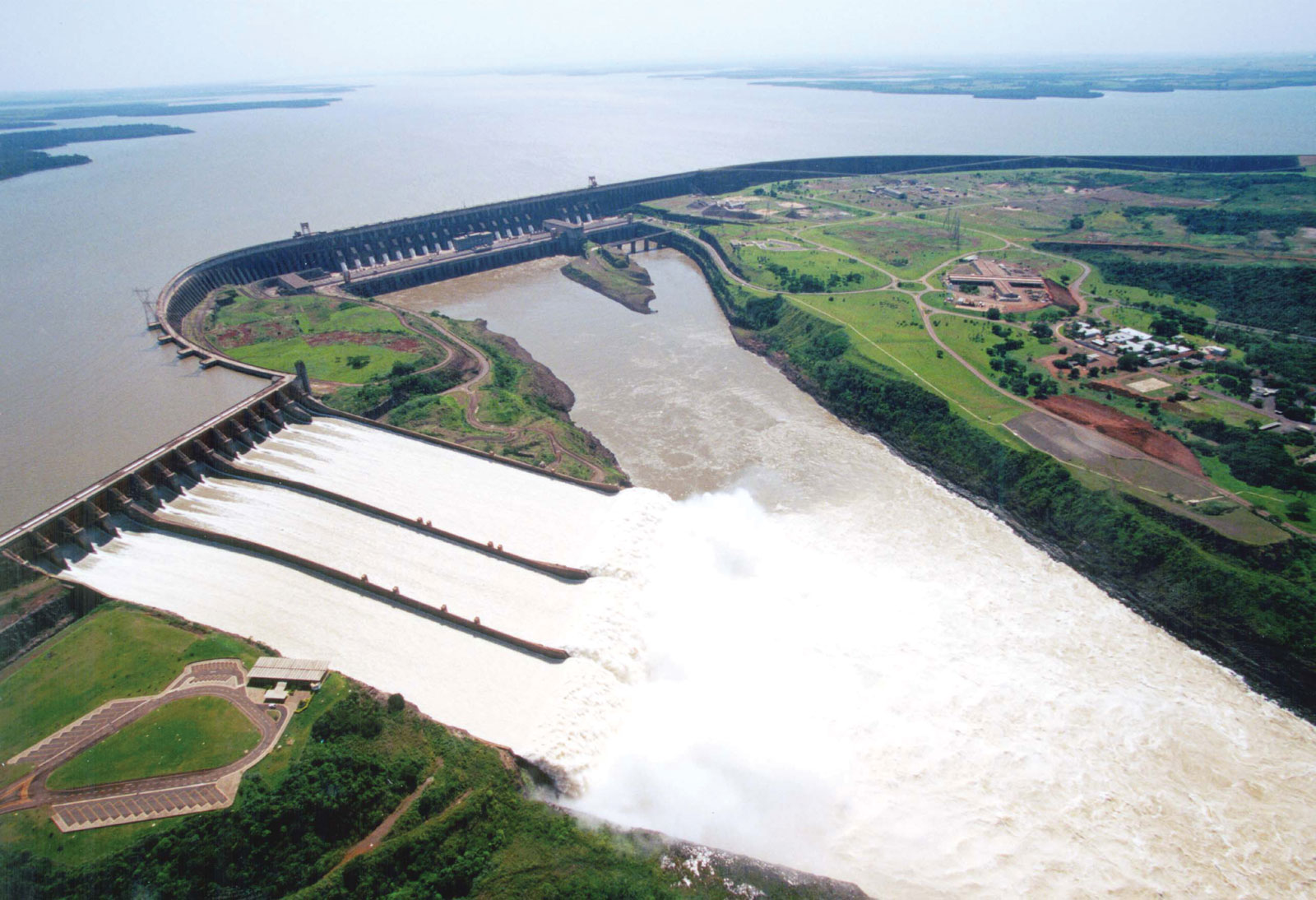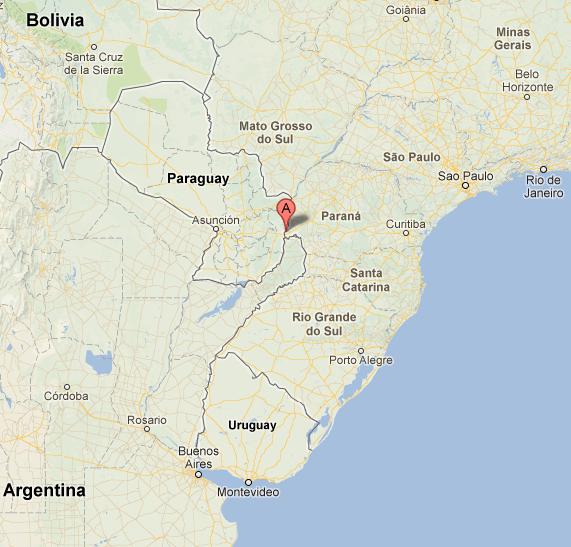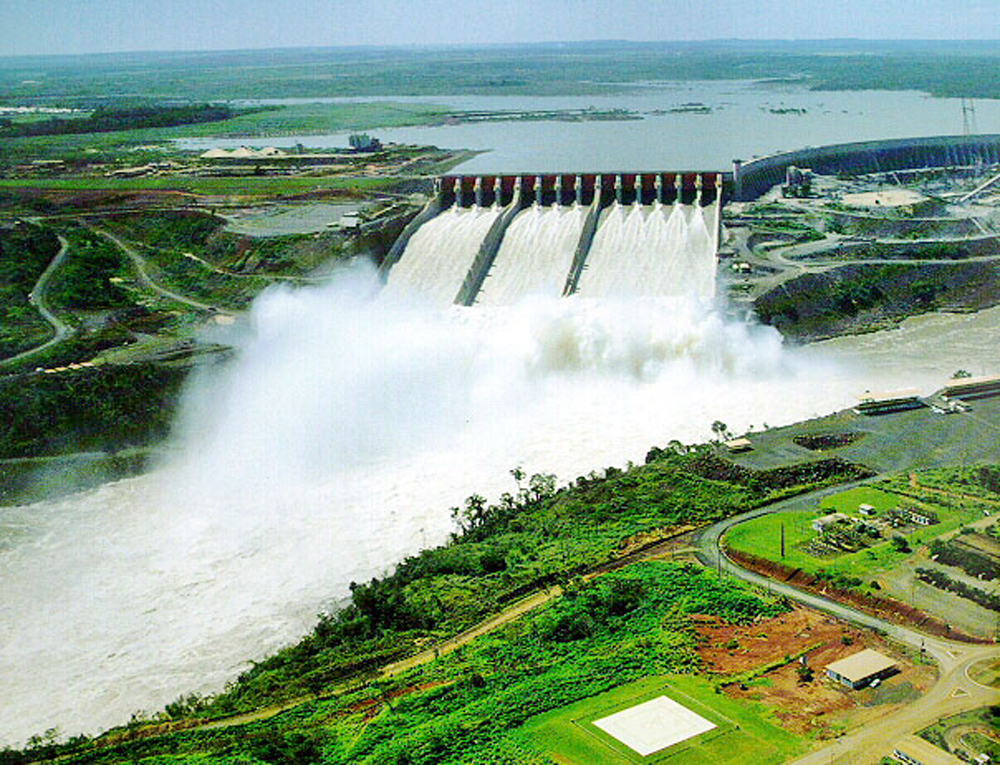<Back to Index>
- Hydroelectric Dam
on the Paraná Itaipu
Dam, 1984
PAGE SPONSOR


The Itaipu Dam (Guarani: Itaipu, Portuguese: Itaipu, Spanish: Itaipú) is a hydroelectric dam on the Paraná River located on the border between Brazil and Paraguay. The name "Itaipu" was taken from an isle that existed near the construction site. In the Guaraní language, Itaipu means "the sounding stone".
The dam is the largest operating hydroelectric facility in terms of annual energy generation, generating 94.7 TWh in 2008 and 91.6 TWh in 2009, while the annual energy generation of the Three Gorges Dam was 80.8 TWh in 2008 and 79.4 TWh in 2009. The dam's 14,000 MW installed capacity is second to the Three Gorges Dam's 22,500 MW, though. It is a binational undertaking run by Brazil and Paraguay at the Paraná River on the border section between the two countries, 15 km (9.3 mi) north of the Friendship Bridge. The project ranges from Foz do Iguaçu, in Brazil, and Ciudad del Este in Paraguay, in the south to Guaíra and Salto del Guairá in the north. The installed generation capacity of the plant is 14 GW, with 20 generating units providing 700 MW each with a hydraulic design head of 118 m. In 2008 the plant generated a record 94.68 TWh, supplying 90% of the electricity consumed by Paraguay and 19% of that consumed by Brazil.
Of the twenty generator units currently installed, ten generate at 50 Hz for Paraguay and ten generate at 60 Hz for Brazil. Since the output capacity of the Paraguayan generators far exceeds the load in Paraguay, two 600 kV HVDC lines, each approximately 800 km long, carry the majority of the Paraguayan energy to São Paulo where the terminal equipment converts the power to 60 Hz.
The concept behind Itaipu Power Plant was the result of heavy negotiations between the two countries during the 1960s. The "Ata do Iguaçu" (Iguaçu Act) was signed on July 22, 1966, by the Brazilian and Paraguayan Ministers of Foreign Affairs, Juracy Magalhães and Sapena Pastor, respectively. This was a joint declaration of the mutual interest in studying the exploitation of the hydric resources that the two countries shared in the section of the Paraná River starting from, and including, the Salto de Sete Quedas, to the Iguaçu River's watershed. The Treaty that gave origin to the power plant was signed in 1973.
The terms of the treaty, which expires in 2023, have been the subject of widespread discontent in Paraguay. The government of President Lugo vowed to renegotiate the terms of the treaty with Brazil, which long remained hostile to any renegotiation.
In 2009, Brazil agreed to a fairer payment of electricity to Paraguay and also allowed Paraguay to sell excess power directly to Brazilian companies instead of solely through the Brazilian electricity monopoly.
In 1970, the consortium formed by the companies IECO (from the United States of America) and ELC Electroconsult S.p.A. (from Italy) won the international competition for the realization of the viability studies and for the elaboration of the construction project. Work began in February 1971. On April 26, 1973, Brazil and Paraguay signed the Itaipu Treaty, the legal instrument for the hydroelectric exploitation of the Paraná River by the two countries. On May 17, 1974, the Itaipu Binacional entity was created to administer the plant's construction. The works began in January of the following year. Brazil's (and Latin America's) first electric car was introduced in late 1974; it received the name "Itaipu" in honor of the project.
On October 14, 1978, the Paraná River had its route changed, which allowed a section of the riverbed to dry so the dam could be built there.
An important diplomatic settlement was reached with the signing of the Acordo Tripartite by Brazil, Paraguay and Argentina, on October 19, 1979. This agreement established the allowed river levels and how much they could change as a result of the various hydroelectric undertakings in the watershed that was shared by the three countries. At that time, the three countries were ruled by military dictatorships. Argentina was concerned that, in the event of a conflict, Brazil could open the floodgates, raising the water level in the Río de la Plata and consequently flood the capital city of Buenos Aires.
The plant's reservoir began its formation on October 13, 1982, when the dam works were completed and the side canal's gates were closed. Throughout this period, heavy rains and flooding accelerated the filling of the reservoir as the water rose 100 meters (330 ft) and reached the gates of the spillway at 10 a.m. on October 27.
On May 5, 1984, the first generation unit started running in Itaipu. The first 18 units were installed at the rate of two to three a year; the last two of these started running in the year 1991.
The last two of the 20 electric generation units started operations in September 2006 and in March 2007, thus raising the installed capacity to 14 GW and completing the power plant. This increase in capacity will allow for 18 generation units to remain running all of the time while two stay down for maintenance. Due to a clause in the treaty signed between Brazil, Paraguay and Argentina, the maximum number of generating units allowed to operate simultaneously cannot exceed 18.
The rated nominal power of each generating unit (turbine and generator) is 700 MW. However, because the head (difference between reservoir level and the river level at the foot of the dam) that actually occurs is higher than the designed head (118 m), the power available exceeds 750 MW half of the time for each generator. Each turbine generates around 700 MW; by comparison, all the water from the Iguaçu Falls would have the capacity to feed only two generators.
On November 10, 2009, transmission from the plant was totally disrupted, possibly due to a storm damaging up to three high voltage distribution lines. Itaipu itself was not damaged. This caused massive power outages in Brazil and Paraguay, blacking out the entire country of Paraguay for 15 minutes, and plunging Rio de Janeiro and São Paulo into darkness for more than 2 hours. 50 million people were reportedly affected. The blackout hit at 10:13 p.m. local time. It affected the southeast of Brazil most severely, leaving São Paulo, Rio de Janeiro and Espírito Santo completely without electricity. Blackouts also swept through the interior of Rio Grande do Sul, Santa Catarina, Mato Grosso do Sul, Mato Grosso, the interior of Bahia and parts of Pernambuco, energy officials said. By 12:30 a.m. power had been restored to most areas.
In 1994, the American Society of Civil Engineers elected the Itaipu Dam as one of the seven modern Wonders of the World. In 1995, the American magazine Popular Mechanics published the results.
When construction of the dam began, approximately 10,000 families living beside the Paraná River were displaced.
The world's largest waterfall by volume, the Guaíra Falls were drowned by the newly formed Itaipu reservoir. The Brazilian government liquidated the Guaíra Falls National Park, and dynamited the submerged rock face where the falls had been, facilitating safer navigation, but eliminating the possibility of restoring the falls in the future. A few months before the reservoir was filled, 80 people died when an overcrowded bridge overlooking the falls collapsed, as tourists sought a last glimpse of the falls.
The American composer Philip Glass has also written a symphonic cantata named Itaipu, in honor of the structure.
- The course of the seventh biggest river in the world was shifted, as were 50 million tons of earth and rock.
- The amount of concrete used to build the Itaipu Power Plant would be enough to build 210 football stadiums the size of the Estádio do Maracanã.
- The iron and steel used would allow for the construction of 380 Eiffel Towers.
- The volume of excavation of earth and rock in Itaipu is 8.5 times greater than that of the Channel Tunnel and the volume of concrete is 15 times greater.
- Around forty thousand people worked in the construction.
- Itaipu is one of the most expensive objects ever built.
- The total length of the dam is 7235 m. The crest elevation is 225 m. Itaipu is actually four dams joined together — from the far left, an earth fill dam, a rock fill dam, a concrete buttress main dam, and a concrete wing dam to the right.
- The spillway has a length of 483 m.
- The maximum flow of Itaipu's fourteen segmented spillways is 62.2 thousand cubic meters per second, into three ski-slope formed canals. It is equivalent to 40 times the average flow of the nearby natural Iguaçu Falls.
- The flow of two generators (700 m3·s−1 each) is roughly equivalent to the average flow of the Iguaçu Falls (1500 m3·s−1).
- If Brazil were to use Thermal Power Generation to produce the electric power of Itaipu, 434,000 barrels (69,000 m3) of petroleum would have to be burned every day.
- The dam is 196 meters high, equivalent to a 65-story building.
- Though it is the seventh largest reservoir in size in Brazil, the Itaipu's reservoir has the best relation between electricity production and flooded area. For the 14,000 MW installed power, 1350 square kilometers were flooded. The reservoirs for the hydroelectric power plants of Sobradinho Dam, Tucuruí Dam, Porto Primavera Dam, Balbina Dam, Serra da Mesa Dam and Furnas Dam are all larger than the one for Itaipu, but have a smaller installed generating capacity. The one with the largest hydroelectric production, Tucuruí, has an installed capacity of 8,000 MW, while flooding 2,430 km2 (938 sq mi) of land.
